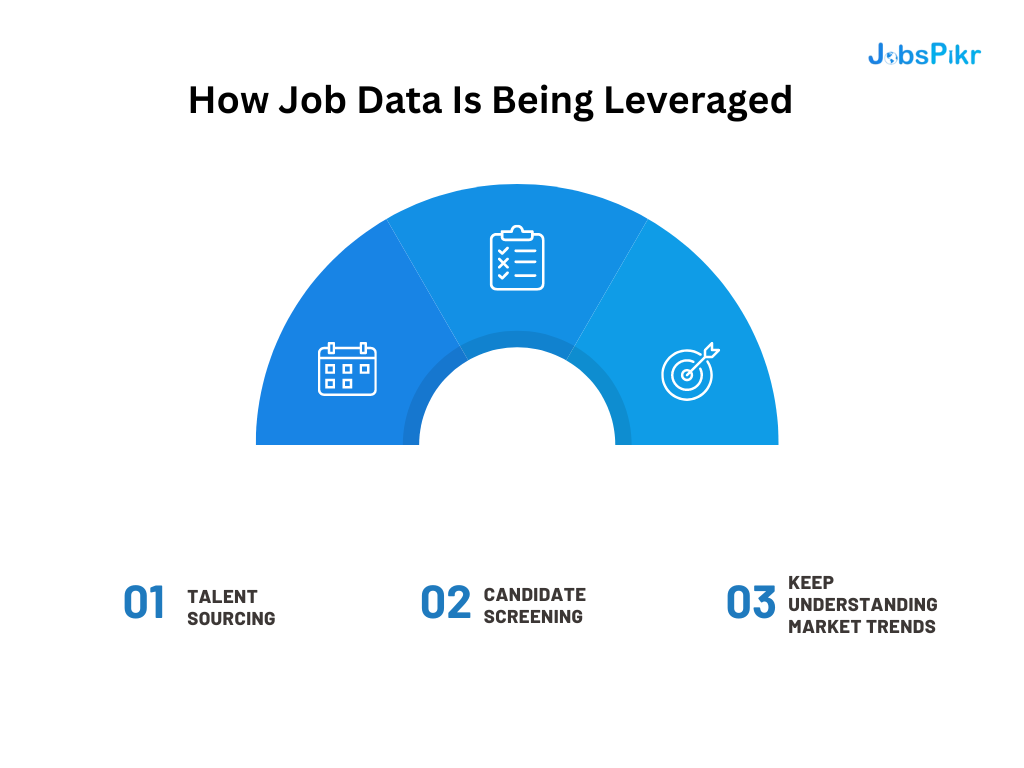The advent of data science and big data analytics has provided a new lens for viewing the job market. Traditional methods of recruitment that heavily relied on individual intuition or drawn-out interview processes can now be supplemented and in some cases replaced, by data-driven methods. These methods not only iron out human biases that inevitably creep into recruitment processes but also add a layer of efficiency and accuracy.
To enable data-driven decision-making, job data is essential. It plays a crucial role in providing accurate and reliable information that can shape an organization’s hiring trajectory but also be leveraged as a tool for market intelligence. With unbiased data, businesses can objectively look at industry trends and competitor activity to understand gaps and take the appropriate steps to amend them.
90% of Fortune 500 Companies already use competitive intelligence, a report from Emerald finds. That essentially means staying relevant and ahead in this market requires looking at your competitors and analyzing what they do. So how does job data provide companies with an added advantage? Let’s find out.
How Job Data Is Being Leveraged
Employers today have access to a gigantic pool of job data, drawn from a myriad of internal and external data sources. This data has multifaceted uses.

- Talent Sourcing: Data-driven platforms like LinkedIn, Indeed, and Glassdoor help businesses to identify prospective candidates and reach out to them more efficiently.
- Candidate Screening: Algorithms can analyze resumes and online profiles to rank potential hires based on requisite skills and experiences.
- Understanding Market Trends: Employers can track emerging skills or roles in the industry, helping them adapt their hiring strategies and stay ahead of the competition.
While this answers questions on the talent acquisition process, a large portion of job data – when used correctly – can reveal insights into competitor activities as well.
For example, a company, let’s call it TechStar, working in the technology industry has been seeing consistent news of AI-driven applications and integrations for a few months. The company is looking to adapt and refine its platform to include new innovative solutions but is unsure if that’s the right call. They make enough revenue and work with clients that are happy using their platform.
TechStar, while researching job data, finds that its No.1 competitor has already jumped the gun by expanding its tech staff and hiring several data and AI engineers. This information nudges TechStar in the right direction, making them ramp up their operations in market research, product planning, and development – to see if they too can hop on the AI bandwagon.
What this exercise essentially means is that hadn’t TechStar looked at job data, it probably would have lost a good portion of its clients to its competitor offering a better, innovative solution. Instead of becoming obsolete TechStar made itself a top contender in its industry once again.
Job Data for Competitor Activity
The above example is a good way to visualize the positive impact job data has on an organization. It’s particularly useful in discerning –
- Skill Requirements: The skills and qualifications that competitors are seeking in their potential employees can indicate the direction they are heading in. For instance, if a competitor starts hiring experts in data analytics and data science, it might indicate that they’re planning to incorporate analytics or some data visualization aspects in their operations or services.
- Vacancies Indicating Expansion or Downsizing: A sudden surge in job postings might mean that the competitor is planning to expand in a new market or introduce a new product or service. Conversely, a sharp decline in job postings could suggest downsizing or a shift in strategy.
Image Source: JobsPikr Infographics
This can be extremely beneficial for organizations to know at a given time, how their competitors are performing in the market.
- Job Roles and Descriptions: Changes in job roles and descriptions can reveal new investments in technology, a change in business focus, or the expansion of an existing department. For instance, creating positions for digital transformation specialists suggests that a company is shifting towards a more digitized operation.
- Location of Hiring: The geographical aspect of job postings can provide valuable insights into a competitor’s strategic expansion plans. A surge in job listings within a specific region or targeting candidates proficient in certain languages may hint at a competitor’s intention to tap into new international markets. This can signify not only their confidence in the potential of those markets but also their readiness to invest resources and establish a foothold in those regions.
- Salary Trends: Delving into the pay scale offered in a competitor’s job listings can serve as a window into their financial well-being. If a competitor consistently offers above-average compensation, it could signify a robust financial position and a commitment to attracting top talent. On the other hand, job listings with compensation below industry standards might raise questions about their financial health or potential cost-cutting measures.
- Job Posting-Frequency: The frequency of job postings for similar roles can shed light on a competitor’s internal dynamics. A high turnover rate within their workforce could prompt them to frequently advertise the same positions, potentially indicating issues with employee satisfaction or the work environment. Monitoring this trend might provide early warnings of possible internal challenges that a competitor is grappling with.
These specific areas of knowledge can be an important source of information. By keeping up-to-date with these aspects of competitor job data, businesses can anticipate their rivals’ actions, helping them to strategically plan their resources, operations, and strategies more effectively.
Platforms like JobsPikr, help organizations with market data in the industry, domain, and region of their choice. By scraping over 70,000 sources daily, with over 1 million jobs scanned, JobsPikr’s data is reliable and up-to-date on recent developments.
This actionable intelligence, when analyzed correctly, can become a competitive advantage in today’s volatile business landscape.
For more details about our product, contact us at sales@jobspikr.com



